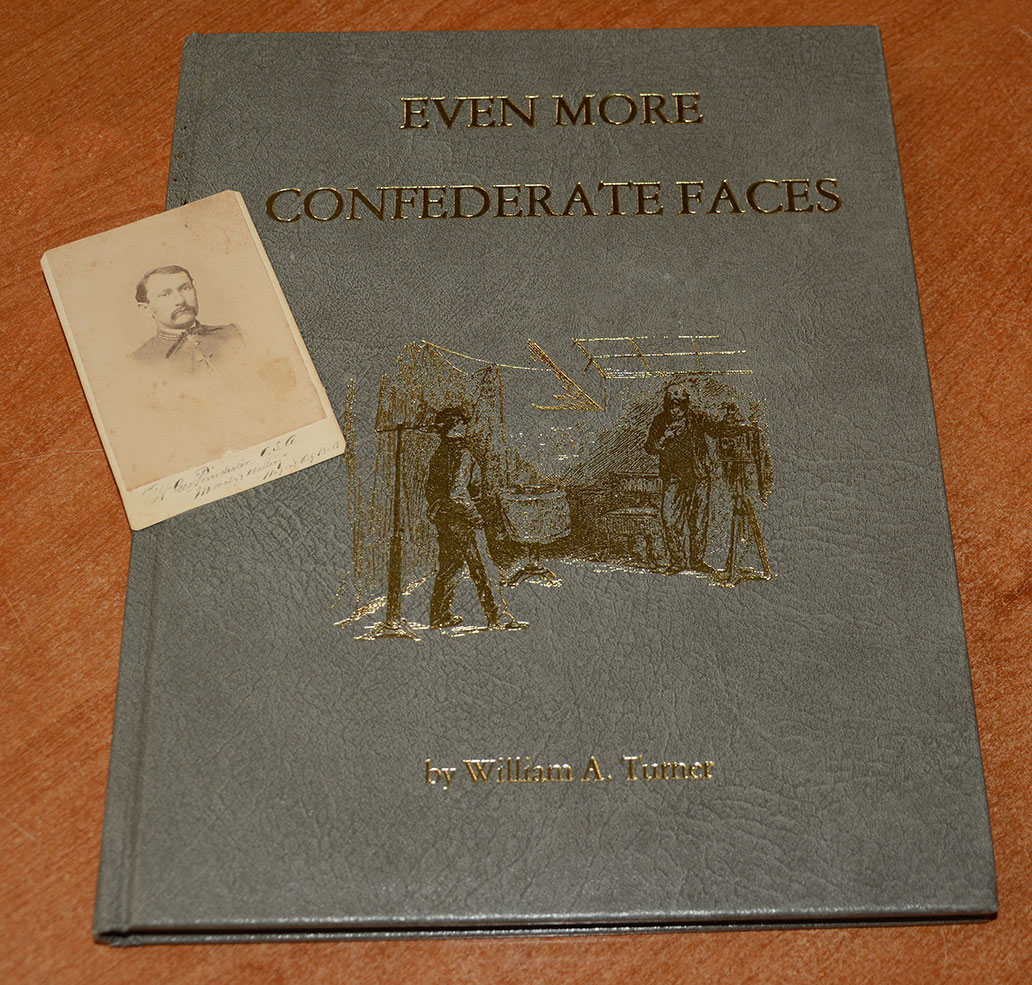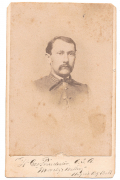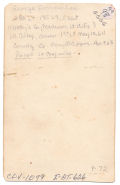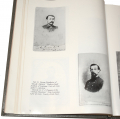site search
online catalog
CS SIGNED CDV, LT. GEORGE POINDEXTER: BALTIMORE LIGHT ARTILLERY AND LOUISIANA MADISON ARTILLERY (“MOODY’S BATTERY”) - “MORE CONFEDERATE FACES” - WITH COPY OF THE BOOK

$1,450.00 SOLD
Quantity Available: None
Item Code: 149-60
This is a very clear, signed vignette bust portrait in carte-de-visite format of a Confederate officer in uniform, illustrated in Bill Turner’s “More Confederate Faces,” a signed copy of which comes with the photograph. The officer has short hair, a drooping, but well-trimmed mustache, a low standing collar showing the two gold braid rank bars of a Confederate First Lieutenant. He wears a gray, single-breasted jacket with the upper three, small buttons visible, the top one fastened and the lapel open below that, and wears a narrow dark bowtie showing a small knot at the front of his white shirt collar, with the long, loose ends of the tie extending out to either side and a slight downward angle. The albumen shows some slight foxing, but only two or three small, thin spots even touching the uniform and none on the face. The edges are slightly clipped for album insertion. The lower edge of the albumen shows a little bit of roughness, and a shallow nick at lower right center. The back of the card is blank except for modern pencil collector notes and codes. The lower face of the card is nicely and legibly autographed in black ink: “1st Lt Geo Poindexter. C.S.A. / “Moody’s Battery” / Huger’s Arty. Batt.”
Moody’s Battery, also known as the “Madison Artillery” was from Louisiana and fought in the Army of Northern Virginia. The photo dates sometime after mid-1864 when Poindexter reached the rank of First Lieutenant, and was the battery commander from then until the end of the war. Poindexter had been appointed to the battery as 2nd Lieutenant on Sept. 11, 1863, which he accepted on Sept. 14. Confederate bureaucracy being no swifter than any other kind, the appointment was confirmed June 9, 1864, giving him rank from July 30, 1863, a procedure that apparently overlapped his promotion to 1st Lieutenant with rank from May 12, 1864. Ironically, Poindexter seems to have had no connection with Louisiana and state pride being what it was, his appointment seems unlikely, but the battery needed another lieutenant and the Louisiana sergeant in line for the promotion had failed his examination. It may be that Lt. George Burroughs, a Marylander serving in the unit, and commanding it after Capt. Moody was sidelined, had some influence in the choice, since Poindexter’s first service was with a Maryland battery, though, in another irony, he seems to have had no connection with that state either.
Born in 1838, Poindexter was from a prominent Virginia family, lived in Lexington, studied law at Washington College (now Washington and Lee,) and is among their alumni of 1855-56, along with a brother. He moved to Mississippi to practice law in 1859, and when the war began returned to Virginia where he enlisted in the Baltimore Light Artillery (also known as the 2nd Maryland Battery,) which was organizing at Richmond, mustering in with them on August 15, 1861, as a sergeant. The battery saw active service in the Army of the Valley and Army of Northern Virginia, seeing action at Harrisonburg, Cross Keys, Port Republic, followed by the Peninsula Campaign, the Second Manassas Campaign, Antietam, Fredericksburg, and other engagements. By early 1863 Poindexter was credited with participation in fourteen battles and skirmishes, and had acted not only as the battery’s ordnance sergeant, but in command of a section, effectively doing duty as an acting lieutenant. In early 1863 he came to the attention of Gen. R.E. Colston, a friend of Stonewall Jackson, a brigade commander, and in line for division command, who petitioned to get Poindexter a commission and posting to his staff as an ordnance officer or as an aide-de-camp. Poindexter was supported by letters of recommendation from General Trimble and others, but Colston’s star was eclipsed by his performance at Chancellorsville and it is unclear how much time Poindexter spent with Colston or with his battery in 1863, but the battery saw continued action in the Gettysburg Campaign. Nevertheless, Poindexter’s commission and appointment to Moody’s Battery as their Junior 2nd Lieutenant in September puts him with that unit in time for their foray west with Longstreet. They were too late for Chickamauga, but took part in the Knoxville Campaign of November and December, fighting at Campbell’s Station and in the Siege of Knoxville. When Longstreet called off the siege in late December, the battery was trusted enough to mask the withdrawal by remaining in place and continuing to fire until nightfall.
The battery returned to Virginia by April 1864 in time to face Grant’s Overland Campaign, missing the Wilderness, but engaged at Spottsylania, Cold Harbor and other fighting leading up to the siege of Petersburg. Poindexter’s signature appears on the battery’s March-April muster roll as Lieutenant commanding the battery. This may was likely temporary, but became a fact after Lt. Burroughs was killed at Spottsylvania and Poindexter was promoted, receiving a commission as 1st Lieutenant with rank from May 12, 1864, with his name, rank and note that he was commanding the battery on the muster rolls thereafter. His records indicate he was hospitalized for intermittent fever from Aug. 29 to Oct. 12, 1864, and again from Dec. 19, 1864 to January 7, 1865, when he returned to duty. He continued in command of the battery in the Spring of 1865 and the retreat to Appomattox, where he was one of just 3 officers and 41 men remaining in the battery to surrender and sign the parole.
Poindexter’s postwar life took him to Georgia and Alabama, more southern states without a clear connection, where he acted as an insurance agent, among other pursuits, but died at age 78 in 1916 during a visit Wytheville, Virginia, and was buried back in his home ground of Lexington, something of a full circle.
This is great image, nicely inscribed, of an officer with some very active and very interesting service. This comes with a copy of Bill Turner’s “Even More Confederate Faces,” in the deluxe limited edition of 100, number 29, inscribed and signed by the author to a collector. The image is shown on page 72. [sr][ph:L]
~~~~~~~~~~~~~~~~~~~~~~~~~~~~~~~~~~~
THIS ITEM, AS WITH ALL OTHER ITEMS AVAILABLE ON OUR WEB SITE,
MAY BE PURCHASED THROUGH OUR LAYAWAY PROGRAM.
CLICK HERE FOR OUR POLICIES AND TERMS.
THANK YOU!
Inquire About CS SIGNED CDV, LT. GEORGE POINDEXTER: BALTIMORE LIGHT ARTILLERY AND LOUISIANA MADISON ARTILLERY (“MOODY’S BATTERY”) - “MORE CONFEDERATE FACES” - WITH COPY OF THE BOOK
For inquiries, please email us at [email protected]
Most Popular
Historical Firearms Stolen From The National Civil War Museum In Harrisburg, Pa »
Theft From Gravesite Of Gen. John Reynolds »
Fine Condition Brass Infantry Bugle Insignia »
Selection Of Unframed Prints By Don Troiani »
Wonderful Condition Original Confederate-Manufactured Kepi For A Drummer Boy Or Child »
featured item
SCARCE 1859 DATED AMES LIGHT CAVALRY SABER, AKA MODEL 1860
Old habits die hard. Although we now know production of the new pattern cavalry saber intended to replace the heavy Model 1840 started in 1857, most still refer to them as the Model 1860. This is a scarce example of one produced by Ames in 1859 and… (2022-718). Learn More »










